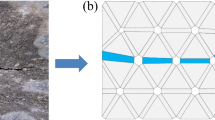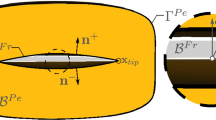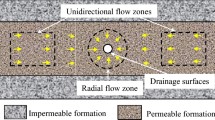Abstract
Hydraulic fracturing is a complicated hydromechanical coupled process, especially in shale gas and deep geothermal reservoirs, in which natural fractures exist. Due to the geological complexity caused by invisibility, and the challenge and high cost in field investigations, numerical modeling becomes an alternative. In this paper, an integrated numerical model is developed to investigate the hydromechanical behavior of a natural fracture during the fluid injection. In the developed model, the mechanical behavior of the fracture including fracture opening, closure, shear dilation, and shear failure is described by proposed constitutive equations; meanwhile, the hydraulic process is simplified as the fluid flows through two parallel planes. The coupled mechanical and hydraulic equations are sequentially formulated in an implicit schema by combining the finite different method and the finite volume method. The advantage of this numerical schema is that the two coupled processes are solved separately and only one sub-iteration is needed. Thus, the solution is efficient and stable than that formulated in a monolithic coupling. Besides, the implicit formulation of the flow equation makes it possible to set a relative large time step. The developed model is verified through three numerical examples. Then, it is used to investigate the hydromechanical behavior of a natural fracture during the fluid injection with a fictive reservoir. Sensitivity studies with variations in the stress state, the fluid injection rate, the fluid viscosity, and the injection form are conducted. The simulation results show that the mechanism in the far field is mainly dominated by shear dilation in contact condition, whereas the mechanism near the injection could be mixed shear–tension in either the contact or the separation conditions. With the increase in the shear stress and the injection length, decrease in the injection rate and the fluid viscosity, the fracture state near the injection will change from separation to contact, the injection pressure will decline below the primary normal stress, and the dominated mechanism is shear dilation. The findings in this study give a better understanding of the mechanical mechanism and the pressure response of a natural fracture during the fluid injection.






























Similar content being viewed by others
Abbreviations
- b i :
-
Gravity acceleration (m/s2)
- c :
-
Cohesion (Pa)
- D :
-
Physical matrix
- f :
-
External force (N)
- e 1 :
-
Elastic parameter (Pa)
- e 2 :
-
Elastic parameter (Pa)
- F :
-
Total force acting on a grid point (N)
- G :
-
Shear modulus (Pa)
- h :
-
Hydrostatic height (m)
- K :
-
Bulk modulus (Pa)
- k n :
-
Normal stiffness (Pa/m)
- k s :
-
Shear stiffness (Pa/m)
- l c :
-
Characteristic length of the rock mach element (m)
- Qs:
-
Source term (1/s)
- t :
-
Time (s)
- v fi :
-
Fluid velocity in the i-direction (m/s)
- v i :
-
Velocity (m/s)
- w :
-
Fracture aperture (m)
- ε :
-
Strain (-)
- u :
-
Displacement (m)
- ρ f :
-
Fluid density (kg/m3)
- ρ m :
-
Rock density (kg/m3)
- σ n,eff = σ n + αP f :
-
Effective normal stress (Pa)
- α :
-
Effective stress coefficient (−)
- σ s :
-
Shear stress (Pa)
- σ n :
-
Normal stress (Pa)
- τ max :
-
Shear strength (Pa)
- ϕ :
-
Frictional angle (°)
- μ :
-
Viscosity (Pa s)
References
Adachia J, Siebritsb E, Peircec A, Desrochesd J (2007) Computer simulation of hydraulic fractures. Int J Rock Mech Min Sci 44:739–757
Casas L, Miskimins JL, Black A, Green S (2006) Laboratory hydraulic fracturing test on a rock with artificial discontinuities. In: SPE annual technical conference and exhibition held in San Antonio, TA, USA, 24–27 Sept 2006
Dinske C, Schapiro SA, Rutledge JT (2010) Interpretation of microseismicity resulting from gel and water fracturing of tight gas reservoirs. Pure Appl Geophys 167:169–182
Economides MJ, Nolte KG (2000) Reservoir stimulation, 3rd edn. Wiley, London
Goodman RE, Taylor RL, Brekke T (1968) A model for the mechanics of jointed rock. J Soil Mech Found Div Proc Am Soc Civ Eng 94(SM3):637–659
Häring MO, Schanz U, Ladner F, Dyer BC (2008) Characterisation of the Basel 1 enhanced geothermal system. Geothermics 37:469–495
Itasca (2007) 3DEC manual, version 4.1. ITASCA Consulting Group, Inc
Itasca (2008) FLAC3D Manual, version 4.0. ITASCA Consulting Group, Inc
Jeffrey RG, Zhang X, Bunger AP (2010) Hydraulic fracturing of naturally fractured reservoirs. In: Proceedings of the 35th workshop on geothermal reservoir engineering held in Stanford, CA, USA, 1–3 Feb 2010
Kresse O, Cohen C, Weng X, Wu R, Gu H (2011) Numerical modeling of hydraulic fracturing in naturally fractured formations. In: Proceedings of the 45th US rock mechanics/geomechanics symposium held in San Francisco, USA, 26–29 June 2011
Nagel N, Gil I, Sanchez-Nagel M (2011) Simulating hydraulic fracturing in real fractured rock—overcoming the limits of pseudo3D models. In: Proceeding of SPE hydraulic fracturing technology conference and exhibition held in Woodlands, TX, USA, 24–26 Jan 2011
Olson JE (2008) Multi-fracture propagation modeling: applications to hydraulic fracturing in shales and tight gas sands. In: Proceedings of the 42nd US rock mechanics symposium held in San Francisco, USA; 29 June–2 July 2008
Réthoré J, de Borst R, Abellan MA (2007) A two-scale approach for fluid flow in fractured porous media. Int J Numer Methods Eng 71:780–800
Watanabe N, Wang W, Taron J, Görke UJ, Kolditz O (2012) Lower-dimensional interface elements with local enrichment: application to coupled hydro-mechanical problems in discretely fractured porous media. Int J Numer Methods Eng 90:1010–1034
Wijesinghe AM (1968) An exact similarity solution for coupled deformation and fluid flow in discrete fractures. Technical report UCID–20675, Lawrence Livermore National Laboratory, Livermore, CA
Witherspoon PA, Wang JSY, Iwai K, Gale JE (1980) Validity of cubic law for fluid flow in a deformable rock fracture. Water Resour Res 16(6):1016–1024
Zhou L, Hou MZ (2013) A new numerical 3D-model for simulation of hydraulic fracturing in consideration of hydro-mechanical coupling effects. Int J Rock Mech Min Sci 60:370–380
Zhou L, Hou MZ, Gou Y, Li M (2014) Numerical investigation of a low-efficient Hydraulic fracturing operation in a tight gas reservoir in the north German basin. J Petrol Sci Eng 120:119–129
Acknowledgments
The work presented in this paper was funded by National Natural Science Foundation of China (No. 51504043) and National Basic Research Program of China (No. 2014CB239206).
Author information
Authors and Affiliations
Corresponding author
Rights and permissions
About this article
Cite this article
Zhou, L., Su, X., Hou, Z. et al. Numerical investigation of the hydromechanical response of a natural fracture during fluid injection using an efficient sequential coupling model. Environ Earth Sci 75, 1263 (2016). https://doi.org/10.1007/s12665-016-6078-3
Received:
Accepted:
Published:
DOI: https://doi.org/10.1007/s12665-016-6078-3




